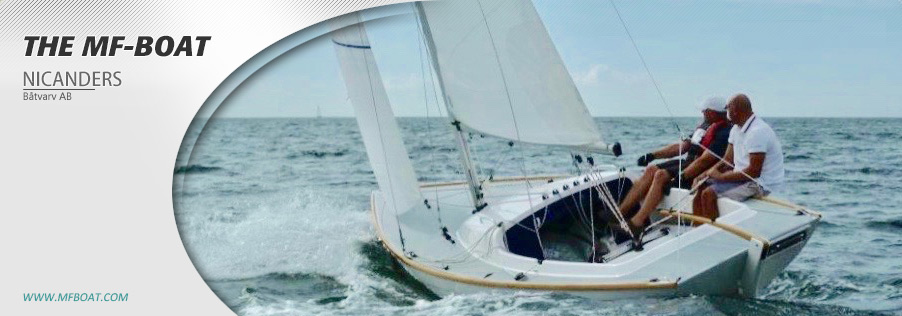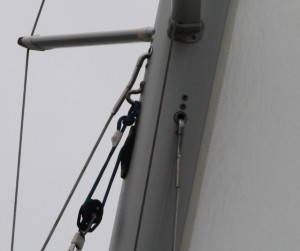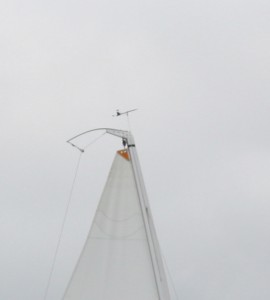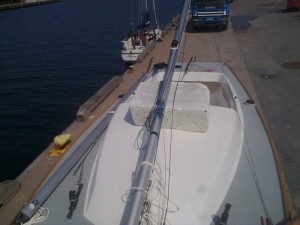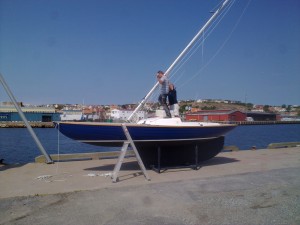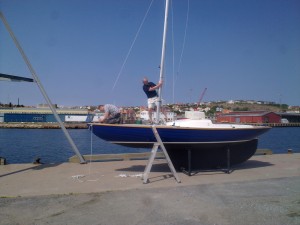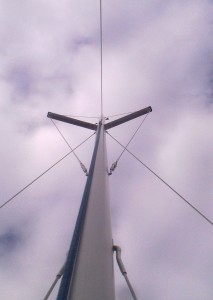Rigging
The MF-boat can be rigged ashore (preferable) or in the water by two persons. Mast weight is about 20 kgs. First time it is advisable to choose a calm day. If possible, align the boat with the wind direction.
Seldén instruction book: First, study the instruction book from the manufacturer Seldén Mast enclosed in the rig package .
Jumpers: Attach the jumpers and the jumper stays on the mast and tighten the rigging screws ( measure to check even tension on both stays) so the stays are tight, then secure the screws with pins and use reinforced tape for protection. Also attach tape around the jumpers, at the inner and outer ends, in way of securing pins and rings.
Forestay and shrouds: Mount the forestay and the shrouds on the mast. Attach the rigging screws on the shrouds. (NB. The forestay has no rigging screw)
Backstay and flexible backstay batten: Mount the flexible backstay batten in the pre-drilled holes for the bolts. Mount the backstay and make sure it runs through the block that should be attached to the batten. Mount the batten on top of the mast with the bolts into the track. Tighten the two nuts, with washers. The batten should be located with its forward end at the forward end of the track. Eventually fit a Windex, which may be mounted on the side of the mast or on the top, (M8 thread) depending of the type of Windex chosen.
Mount the single block at the lower end of the backstay wire.
Jib- and main halyards with single block för gear 1:2 and flexible backstay batten. Photo courtesy: Tommy Andersson/RixMedia
Halyards: Both main and jib halyards have gear 1:2. Mounting: The single block (that connects to the sail head) is thread on the halyard. The main halyard end should be attached to a separate pin at the masthead, aft of the halyard sheave, using a tight bowline knot. The jib halyard end should be attached the same way to an eyestrap right below the forestay.
Make sure the halyards are in order. Attach the main halyard shackle to the gooseneck and tie up the running end. Pull out the jib halyard and attach the running end to the ring for the jib pole. Tie a long line in the jib halyard shackle to use when the mast should be raised if necessary.
– Put the mast alongships with the top pointing aft.
– Attach the upper shrouds to the outer deck eyebolts and unscrew the rigging screws halfways.
First step: The mast in position on deck with support on cabin top and upper shrouds attached before mast is erected
– Carry the mast aft to fasten the mast step with the hinge bolt. Two persons may eventually be needed. One person should stand on aft deck holding the mast during this operation. Put a large fender or similar on the cabin top for protection
– The mast can be erected by two persons. One standing on the cabin top and pulls the mast while the other helps from the cockpit. If there is a third person at hand, use also the jib halyard to pull the mast.
Second step: The mast is easily pushed up by two persons. The hinge at the mast step makes the operation safe.
– After the mast is erected, push it forward and hold it there to stretch the shrouds so the forestay can be connected. Note! Check that the rigging screws can move freely during this operation.
Third step: The mast is up and pushed forward to stretch the shrouds, so that the forestay can be connected.
Finally, tighten shrouds and fit the backstay. For further information look under TUNING.
If you don´t feel comfortable with the method described above, use a crane to step and lower the mast.
